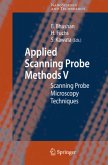Bhushan
Fundamentals of Tribology and Bridging the Gap Between the Macro- and Micro/Nanoscales
Herausgegeben von Bhushan, Bharat
Bhushan
Fundamentals of Tribology and Bridging the Gap Between the Macro- and Micro/Nanoscales
Herausgegeben von Bhushan, Bharat
- Broschiertes Buch
- Merkliste
- Auf die Merkliste
- Bewerten Bewerten
- Teilen
- Produkt teilen
- Produkterinnerung
- Produkterinnerung
The word tribology was fIrst reported in a landmark report by P. Jost in 1966 (Lubrication (Tribology)--A Report on the Present Position and Industry's Needs, Department of Education and Science, HMSO, London). Tribology is the science and technology of two interacting surfaces in relative motion and of related subjects and practices. The popular equivalent is friction, wear and lubrication. The economic impact of the better understanding of tribology of two interacting surfaces in relative motion is known to be immense. Losses resulting from ignorance of tribology amount in the United States…mehr
Andere Kunden interessierten sich auch für
![ICAF 2009, Bridging the Gap between Theory and Operational Practice ICAF 2009, Bridging the Gap between Theory and Operational Practice]() ICAF 2009, Bridging the Gap between Theory and Operational Practice385,99 €
ICAF 2009, Bridging the Gap between Theory and Operational Practice385,99 €![ICAF 2009, Bridging the Gap between Theory and Operational Practice ICAF 2009, Bridging the Gap between Theory and Operational Practice]() ICAF 2009, Bridging the Gap between Theory and Operational Practice386,99 €
ICAF 2009, Bridging the Gap between Theory and Operational Practice386,99 €![Applied Scanning Probe Methods V Applied Scanning Probe Methods V]() Applied Scanning Probe Methods V81,99 €
Applied Scanning Probe Methods V81,99 €![Advances in Scanning Probe Microscopy Advances in Scanning Probe Microscopy]() Advances in Scanning Probe Microscopy74,99 €
Advances in Scanning Probe Microscopy74,99 €![Applied Scanning Probe Methods XII Applied Scanning Probe Methods XII]() Applied Scanning Probe Methods XII83,99 €
Applied Scanning Probe Methods XII83,99 €![IUTAM Symposium on Recent Advances of Acoustic Waves in Solids IUTAM Symposium on Recent Advances of Acoustic Waves in Solids]() IUTAM Symposium on Recent Advances of Acoustic Waves in Solids110,99 €
IUTAM Symposium on Recent Advances of Acoustic Waves in Solids110,99 €![Iutam Symposium on Recent Advances of Acoustic Waves in Solids Iutam Symposium on Recent Advances of Acoustic Waves in Solids]() Iutam Symposium on Recent Advances of Acoustic Waves in Solids110,99 €
Iutam Symposium on Recent Advances of Acoustic Waves in Solids110,99 €-
-
-
The word tribology was fIrst reported in a landmark report by P. Jost in 1966 (Lubrication (Tribology)--A Report on the Present Position and Industry's Needs, Department of Education and Science, HMSO, London). Tribology is the science and technology of two interacting surfaces in relative motion and of related subjects and practices. The popular equivalent is friction, wear and lubrication. The economic impact of the better understanding of tribology of two interacting surfaces in relative motion is known to be immense. Losses resulting from ignorance of tribology amount in the United States alone to about 6 percent of its GNP or about $200 billion dollars per year (1966), and approximately one-third of the world's energy resources in present' use, appear as friction in one form or another. A fundamental understanding of the tribology of the head-medium interface in magnetic recording is crucial to the future growth of the $100 billion per year information storage industry. In the emerging microelectromechanical systems (MEMS) industry, tribology is also recognized as a limiting technology. The advent of new scanning probe microscopy (SPM) techniques (starting with the invention of the scanning tunneling microscope in 1981) to measure surface topography, adhesion, friction, wear, lubricant-fIlm thickness, mechanical properties all on a micro to nanometer scale, and to image lubricant molecules and the availability of supercomputers to conduct atomic-scale simulations has led to the development of a new fIeld referred to as Microtribology, Nanotribology, or Molecular Tribology (see B. Bhushan, J. N. Israelachvili and U.
Produktdetails
- Produktdetails
- NATO Science Series II Mathematics, Physics and Chemistry 10
- Verlag: Springer / Springer Netherlands
- Artikelnr. des Verlages: 978-0-7923-6837-3
- 2001
- Seitenzahl: 1008
- Erscheinungstermin: 31. März 2001
- Englisch
- Abmessung: 240mm x 160mm x 55mm
- Gewicht: 1626g
- ISBN-13: 9780792368373
- ISBN-10: 0792368371
- Artikelnr.: 25854993
- NATO Science Series II Mathematics, Physics and Chemistry 10
- Verlag: Springer / Springer Netherlands
- Artikelnr. des Verlages: 978-0-7923-6837-3
- 2001
- Seitenzahl: 1008
- Erscheinungstermin: 31. März 2001
- Englisch
- Abmessung: 240mm x 160mm x 55mm
- Gewicht: 1626g
- ISBN-13: 9780792368373
- ISBN-10: 0792368371
- Artikelnr.: 25854993
Dr. Bharat Bhushan received an M.S. in mechanical engineering from the Massachusetts Institute of Technology in 1971, an M.S. in mechanics and a Ph.D. in mechanical engineering from the University of Colorado at Boulder in 1973 and 1976, respectively, an MBA from Rensselaer Polytechnic Institute at Troy, NY in 1980, Doctor Technicae from the University of Trondheim at Trondheim, Norway in 1990, a Doctor of Technical Sciences from the Warsaw University of Technology at Warsaw, Poland in 1996, and Doctor Honoris Causa from the Metal-Polymer Research Institute of National Academy of Sciences at Gomel, Belarus in 2000. He is a registered professional engineer (mechanical) and presently an Ohio Eminent Scholar and The Howard D. Winbigler Professor in the Department of Mechanical Engineering, Graduate Research Faculty Advisor in the Department of Materials Science and Engineering, and the Director of the Nanotribology Laboratory for Information Storage & MEMS/NEMS (NLIM) at the Ohio Sta
te University, Columbus, Ohio. He is an internationally recognized expert of tribology on the macro- to nanoscales, and is one of the most prolific authors in the field. He is considered by some a pioneer of the tribology and mechanics of magnetic storage devices and a leading researcher in the fields of nanotribology and nanomechanics using scanning probe microscopy and applications to micro/nanotechnology.
te University, Columbus, Ohio. He is an internationally recognized expert of tribology on the macro- to nanoscales, and is one of the most prolific authors in the field. He is considered by some a pioneer of the tribology and mechanics of magnetic storage devices and a leading researcher in the fields of nanotribology and nanomechanics using scanning probe microscopy and applications to micro/nanotechnology.
1. History.- History of Tribology and Its Industrial Significance.- 2. Adhesion and Friction.- Friction, Wear, Lubrication, and Materials Characterization Using Scanning Probe Microscopy.- Atomic Scale Origin of Adhesion and Friction Viscoelastic Effects in Model Lubricant Monolayers.- Atomic-Scale Stick Slip.- Dissipation Mechanisms Studied by Dynamic Force Microscopies.- Frictional-Force Imaging and Friction Mechanisms with a Lattice Periodicity.- Atomic Scale Origins of Force Interaction.- Dynamic Friction Measurement with the Scanning Force Microscope.- Towards the Ideal Nano-Friction Experiment.- Investigation of the Mechanics of Nanocontacts Using a Vibrating Cantilever Technique.- A Scanning Probe and Quartz Crystal Microbalance Study of C60 on Mica and Silver(111) Surfaces.- Interactions, Friction and Lubrication Between Polymer-Bearing Surfaces.- Effect of Electrostatic Interactions on Frictional Forces in Electrolytes.- Adsorption of Thin Liquid Films on Solid Surfaces and its Relevance for Tribology.- Theory and Simulations of Friction Between Flat Surfaces Lubricated by Submonolayers.- Friction Mechanisms and Modeling on the Macroscale.- Experimental Aspects of Friction Research on the Macroscale.- The Anisotropic Friction Characteristics of Crystalline Materials: A Review.- Relationship Between Structure and Internal Friction in CoPt and FePd Alloys.- Direct Measurement of Surface and Interfacial Energies of Glassy Polymers and PDMS.- A Model for Adhesive Forces in Miniature Systems.- Simple Model for Low Friction Systems.- Ultra-Low Friction Between Water Droplet and Hydrophobie Surface.- A FM as a New Tool in Characterisation of Mesoporous Ceramics as Materials to Tribological Applications.- Discussion Forum Report: Bridging the Gap Between Macro- and Micro/Nanoscale Adhesion and Friction.- 3. Wear.- Modeling (and) Wear Mechanisms.- Surface Damage Under Reciprocating Sliding.- Wear Particle Life in a Sliding Contact Under Dry Conditions: Third Body Approach.- Fretting Wear Behaviour of a Titanium Alloy.- Wear Measurements and Monitoring at Macro- and-Microlevel.- Slurry Erosion: Macro- and Micro- Aspects.- Macro-and Micro Kelvin Probe in Tribological Studies.- Thermomechanics of Sliding Contact: When Micro meets Macro.- Nanostructuring of Calcite Surfaces by Tribomcchanical Etching with the Tip of an Atomic Force Microscope.- Atomic-Scale Processes of Tribomechanical Etching Studied by Atomic Force Microscopy on the Layered Material NbSe2.- Determining the Nanoscale Friction and Wear Behavior of Si, SiC and Diamond by Microscale Environmental Tribology.- On Some Similarities of Structural Modification in Wear and Fatigue.- The Mesostructure of Surface Layers of Metal Under Friction with Relatively High Contact Stress.- The Effect of Impact Angle on the Erosion of Cermets.- Wear Mechanism of Carbon Material-Steel Slide Bearing in Polluted Atmosphere.- Nanomechanical Properties of Brittle Matter.- Testing Tribological Behaviour of loo-Beam Mixed Surface Layers.- Tribological Studies of DLC Films Containing Different Amount of Silicon Coated by Reactive Ion Plating.- Tribological Aspects of Wear of Laser-Sintered Rapid Prototype Tools.- Discussion Forum Report: Bridging the Gap Between Macro- and Micro/Nanoscale Wear.- 4. Lubrication.- On the Effects of Roughness on Structures, Solvation Forces and Shear of Molecular Films in Nano-Confinement.- Nanoscale Lubrication and Friction Control.- Tribology of Ideal and Non-Ideal Surfaces and Fluids.- Nanoscale Wetting and De-Wetting of Lubricants with Scanning Polarization Force Microscopy.- The Study of Very Thin Lubricant Films in High Pressure Contacts Using Spacer Layer Interferornetric Methods.- Scaling Issues in the Measurement of Monolayer Films.- Hew Electrolytes for Electrochemical Study in Hydrocarbon Solution.- Limiting Friction in a Slider-Disk Interface with Nanometer-Scale Lubricant Films.- Friction in Lubricated Contacts: From Macro- to Microscale Effects.-The Present State of the Art on Degradation Models of Perfluoropolyethers with DLC Coatings in Thin-Film Magnetic Rigid Disks.- fluid Film Lubrication with Applications to Machine Elements.- Flow Modeling of Thin Films from Macroscale to Nanoscale.- Discussion Forum Report: Bridging the Gap Between Macro- and Micro/Nanoscale Lubrication.- 5. Applications.- Micro-and Nanostructures: Preparation and Applications.- Micro/Nanoscale Tribology of MEMS Materials, Lubricants and Devices.- Macro- and Microtribology of Information Storage and Retrieval Devices.- High Spatial Resolution Chemical Imaging of Tribo-Surfaccs in Magnetic Recording.- Analysis and Testing of Miniature Motors for Precision Engineering.- Permanent Magnetic Levitation and Stability.- Load Carrying Capacity of Heavy-Duty Porous Journal Bearings.- Manufacturing Applications of Multi-Scale Tribology.- Condition Monitoring Tools for Tribologists.- Author Index.
1. History.- History of Tribology and Its Industrial Significance.- 2. Adhesion and Friction.- Friction, Wear, Lubrication, and Materials Characterization Using Scanning Probe Microscopy.- Atomic Scale Origin of Adhesion and Friction Viscoelastic Effects in Model Lubricant Monolayers.- Atomic-Scale Stick Slip.- Dissipation Mechanisms Studied by Dynamic Force Microscopies.- Frictional-Force Imaging and Friction Mechanisms with a Lattice Periodicity.- Atomic Scale Origins of Force Interaction.- Dynamic Friction Measurement with the Scanning Force Microscope.- Towards the Ideal Nano-Friction Experiment.- Investigation of the Mechanics of Nanocontacts Using a Vibrating Cantilever Technique.- A Scanning Probe and Quartz Crystal Microbalance Study of C60 on Mica and Silver(111) Surfaces.- Interactions, Friction and Lubrication Between Polymer-Bearing Surfaces.- Effect of Electrostatic Interactions on Frictional Forces in Electrolytes.- Adsorption of Thin Liquid Films on Solid Surfaces and its Relevance for Tribology.- Theory and Simulations of Friction Between Flat Surfaces Lubricated by Submonolayers.- Friction Mechanisms and Modeling on the Macroscale.- Experimental Aspects of Friction Research on the Macroscale.- The Anisotropic Friction Characteristics of Crystalline Materials: A Review.- Relationship Between Structure and Internal Friction in CoPt and FePd Alloys.- Direct Measurement of Surface and Interfacial Energies of Glassy Polymers and PDMS.- A Model for Adhesive Forces in Miniature Systems.- Simple Model for Low Friction Systems.- Ultra-Low Friction Between Water Droplet and Hydrophobie Surface.- A FM as a New Tool in Characterisation of Mesoporous Ceramics as Materials to Tribological Applications.- Discussion Forum Report: Bridging the Gap Between Macro- and Micro/Nanoscale Adhesion and Friction.- 3. Wear.- Modeling (and) Wear Mechanisms.- Surface Damage Under Reciprocating Sliding.- Wear Particle Life in a Sliding Contact Under Dry Conditions: Third Body Approach.- Fretting Wear Behaviour of a Titanium Alloy.- Wear Measurements and Monitoring at Macro- and-Microlevel.- Slurry Erosion: Macro- and Micro- Aspects.- Macro-and Micro Kelvin Probe in Tribological Studies.- Thermomechanics of Sliding Contact: When Micro meets Macro.- Nanostructuring of Calcite Surfaces by Tribomcchanical Etching with the Tip of an Atomic Force Microscope.- Atomic-Scale Processes of Tribomechanical Etching Studied by Atomic Force Microscopy on the Layered Material NbSe2.- Determining the Nanoscale Friction and Wear Behavior of Si, SiC and Diamond by Microscale Environmental Tribology.- On Some Similarities of Structural Modification in Wear and Fatigue.- The Mesostructure of Surface Layers of Metal Under Friction with Relatively High Contact Stress.- The Effect of Impact Angle on the Erosion of Cermets.- Wear Mechanism of Carbon Material-Steel Slide Bearing in Polluted Atmosphere.- Nanomechanical Properties of Brittle Matter.- Testing Tribological Behaviour of loo-Beam Mixed Surface Layers.- Tribological Studies of DLC Films Containing Different Amount of Silicon Coated by Reactive Ion Plating.- Tribological Aspects of Wear of Laser-Sintered Rapid Prototype Tools.- Discussion Forum Report: Bridging the Gap Between Macro- and Micro/Nanoscale Wear.- 4. Lubrication.- On the Effects of Roughness on Structures, Solvation Forces and Shear of Molecular Films in Nano-Confinement.- Nanoscale Lubrication and Friction Control.- Tribology of Ideal and Non-Ideal Surfaces and Fluids.- Nanoscale Wetting and De-Wetting of Lubricants with Scanning Polarization Force Microscopy.- The Study of Very Thin Lubricant Films in High Pressure Contacts Using Spacer Layer Interferornetric Methods.- Scaling Issues in the Measurement of Monolayer Films.- Hew Electrolytes for Electrochemical Study in Hydrocarbon Solution.- Limiting Friction in a Slider-Disk Interface with Nanometer-Scale Lubricant Films.- Friction in Lubricated Contacts: From Macro- to Microscale Effects.-The Present State of the Art on Degradation Models of Perfluoropolyethers with DLC Coatings in Thin-Film Magnetic Rigid Disks.- fluid Film Lubrication with Applications to Machine Elements.- Flow Modeling of Thin Films from Macroscale to Nanoscale.- Discussion Forum Report: Bridging the Gap Between Macro- and Micro/Nanoscale Lubrication.- 5. Applications.- Micro-and Nanostructures: Preparation and Applications.- Micro/Nanoscale Tribology of MEMS Materials, Lubricants and Devices.- Macro- and Microtribology of Information Storage and Retrieval Devices.- High Spatial Resolution Chemical Imaging of Tribo-Surfaccs in Magnetic Recording.- Analysis and Testing of Miniature Motors for Precision Engineering.- Permanent Magnetic Levitation and Stability.- Load Carrying Capacity of Heavy-Duty Porous Journal Bearings.- Manufacturing Applications of Multi-Scale Tribology.- Condition Monitoring Tools for Tribologists.- Author Index.








